This morning we once again said our goodbyes. Colin spent the day puttering around Kosmos and the marina, spending most of his time reading and enjoying the sun between bursts of rain until it was time to take a cab to the airport. Eric and Christi went for a drive to check out Basse Terre.
From Pointe a Pitre we took the highway across Salt River over to the Basse Terre side, then took the coastal road south. The top of the mountains were enshrouded in a thick cloud, and as the road took us higher and lower, we’d pass in and out of the cloud cover. Inside the cloud cover it was cool and damp. Outside the cover it was idyllic temperatures. It rained on and off. We would occasionally see glimpses of the ocean through the clouds.
The entire southeast coast of the island looks to be mostly farm land dotted with houses. There seemed to be a lot of fields of bananas and sugar cane. We also saw a lot of breadfruit trees and coconut palms around, but it looked like these trees were grown in smaller quantities, not in enormously large fields. The plants seem to all be thriving. Some of the houses on the farms are nice, some are not. The architectural styles varied from palatial plantation looking homes to literal shacks, but the biggest percentage are one or two story bungalows with slanted metal roofs and gingerbread trim. Most all of the well maintained houses are painted in bright, cheerful colors.
We passed through a couple of small towns, so small that they are not much more than a small cluster of buildings along the side of the road. After we rounded the corner to the south end of the island, the farms thinned out, the residences got closer together and there were more of them. As we approached the town of Basse Terre on the southwest end of the island, it became increasingly urban. The downtown “main street” area is lined with traditional narrow buildings that have a retail shop on the first floor and living quarters above the shop. Most of the buildings are definitely older, but well maintained, simple and attractive. There aren’t many brand new places, nor are there many dilapidated places. It is a cute town and much, much nicer than Pointe a Pitre. The outer edges of town have some bigger buildings, such as four story apartment complexes and a big gothic style Catholic church.
We were really surprised to find that there was a huge traffic jam in downtown. Traffic was simply not moving, which gave us some time to get a closer look at our surroundings. Eventually we made it through the pile up. We made a few turns to explore some of the side streets before getting back on the main highway and continuing north along the west coast.
The west coast is certainly much more built up than the east coast. It looks to be mostly residential houses on fairly large lots, and once again, the style and upkeep of the houses varies dramatically. But this is definitely a higher end district, with more nicer homes and less run down places. There are small pockets of commercial here and there, which probably represent small towns. In between the construction there is lots of lush plant life. The road winds up and down the various mountains along the coast, and the views from the road are phenomenal, both of the seashore and of the pretty tropical landscape. There are a few attractive beaches here and there, but most of the time the shore is rocky. The cloud cover had thinned out by now, but temperatures were still ideal and it was still raining on and off.
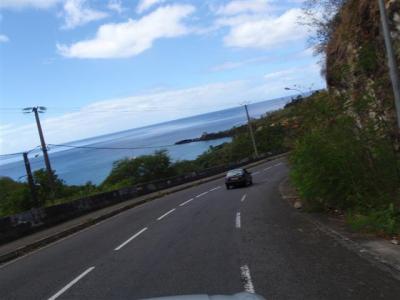
When we got to the town of Vieux-Habitants, about 1/3 of the way up the coast, we stopped in at the coffee museum. It is a complex with three traditional style metal roofed buildings. One houses a gift shop, one is the actual museum, and one is an active coffee packing plant. The grounds are a beautifully landscaped garden, which prominently feature various plants that are important to Guadeloupe, including vanilla, coffee, cocoa, and bananas. The grounds are also dotted with assorted coffee processing equipment of yesteryear. We like the first shot because you can see the architectural style and the garden in the background. The second photo is of cocoa, which we have never seen cultivated before.
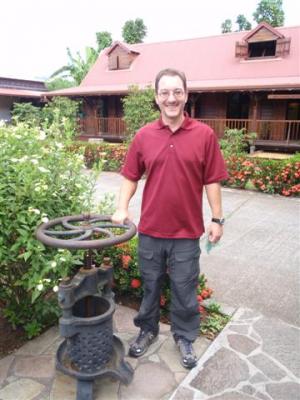
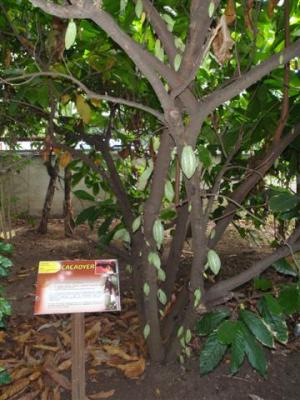
The museum is small, but jam packed. There aren’t a lot of display pieces, and quite honestly, the pieces aren’t very exciting, but virtually every inch of wall space is covered with brightly colored, informative signs explaining various aspects of coffee — from the plant itself, to growing the plant, to processing it, to the impact coffee has on the world through history up until today. Sadly, all the signs in the museum are in French, so needless to say, we didn’t get a lot out of it. The signs had pictures, so we did learn a few things, at least. For example, we saw a picture that shows which countries in the world grow coffee, and which varieties of coffee they grow. Another chart compared caffeine quantities between coffee, tea, cola and chocolate. Dark chocolate has more caffeine than green tea! In Europe, 60% of all caffeine consumed is via coffee, 30% via tea, 10% from cola and the rest is from chocolate and drugs that contain caffeine (such as Excedrin). It is estimated that world wide, 1,400,000,000 cups of coffee are consumed per day.
We did find a little write up about coffee in a tourist brochure we had picked up earlier, so this seems like a good place to add what we learned. Coffee apparently originated in Ethiopia. The Yemeni’s started to farm it in the 14th century and in the 15th century westerners discover it. In 1723, coffee farming was introduced in the Caribbean. Guadeloupe grew a variety called Bourbon Arabica that was highly sought out in the 19th century, and they exported 4,000 tons of it a year. Coffee production fell dramatically in the 20th century and Guadeloupe only exports 20 tons a year now.
The coffee packing facility was interesting. The entire system is automated, utilizing a big machine with lots of tubes and bins built into it. There were only two people working one that took the finished bags of coffee and packed them into boxes, and another guy who seemed to be making sure the equipment continued to run smooth. From what we could tell, after the beans were picked, they were left in the sun to dry. The drying bins were in front of the building. The workers must dump the beans into the machine. We guess the machine roasts the beans, then moves the beans to another bin where they are ground, then to a third bin that bags it. The bagging fascinated us. The plastic is an endless tube. The machine fills the tube with coffee, and at perfect intervals the machine cuts and simultaneously seals the full plastic, turning the big tube into a whole bunch of individual bags.
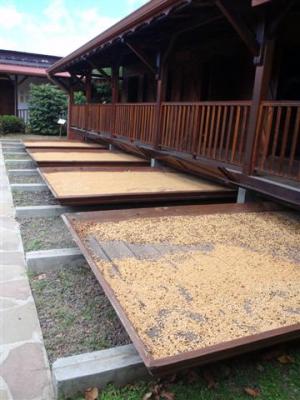

In the gift shop we were given a complimentary cup of coffee. It was OK. It was nowhere near as smooth as the coffee we tried in Indonesia, but it is certainly not as bitter as Colombian. The gift shop sold an odd assortment of items in addition to coffee.
We hopped back in the car and continued north until we saw a restaurant that caught our eye. It is basically a covered patio located on a small stretch of beach kind of in the middle of nowhere. We decided to give it a try. The set menu included a “˜Ti Punch, which seems to be the most popular beverage on the island. “˜Ti Punch is a big shot of rum with a spoonful of sugar and a generous squeeze of lime. Christi took a sip and her chest was instantly on fire. They definitely didn’t water down the rum! We ordered an appetizer called Boudin Creole. We had no idea what it was, but we were feeling adventurous. Out came a salad topped with three little black things about the size and shape of eggs. What were they? Eric cut into them. The outside was like a sausage wrapper, and the inside was squishy, like a soft cheese. We each took a bite. It tasted meaty, smoky and spicy different than anything we’ve had before, and good. It made a great spread on the bread.
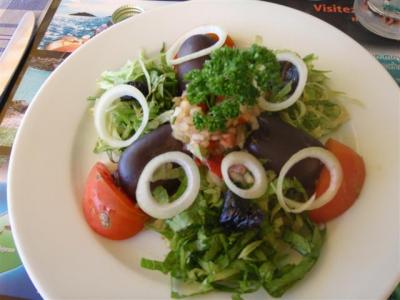
We again got accras, and this time they were even better. Eric again ordered poisson cru, hoping it would be real French Polynesian style. This restaurant’s version is more like what we would call a ceviche. It had lots of lime, scallions a hint of jalapeno, and no coconut milk. Christi ordered grilled fish, and her meal came with two side dishes that were awesome. One was stuffed christophene. Christophene is a veggie that looks kind of like a shriveled up pear. Neither of us have ever tasted it before. It was served like a twice baked potato and had bacon pieces mixed in there and cheese on top. The other side dish was sweet potatoes cooked up like fat beef steak fries.
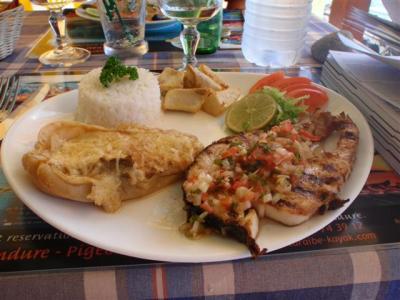
The food was excellent and the views were nice. We spent a lot of time watching a pelican on the food hunt. He’d fly around the bay, then suddenly do an amazingly fast nose dive into the water as he went after a fish. One time we actually saw him catch the fish and watched as he proudly gobbled it up.
When we were done eating, we continued north up to the town of Deshaies, which is”¦ to be continued”¦

You certainly enjoy eating food